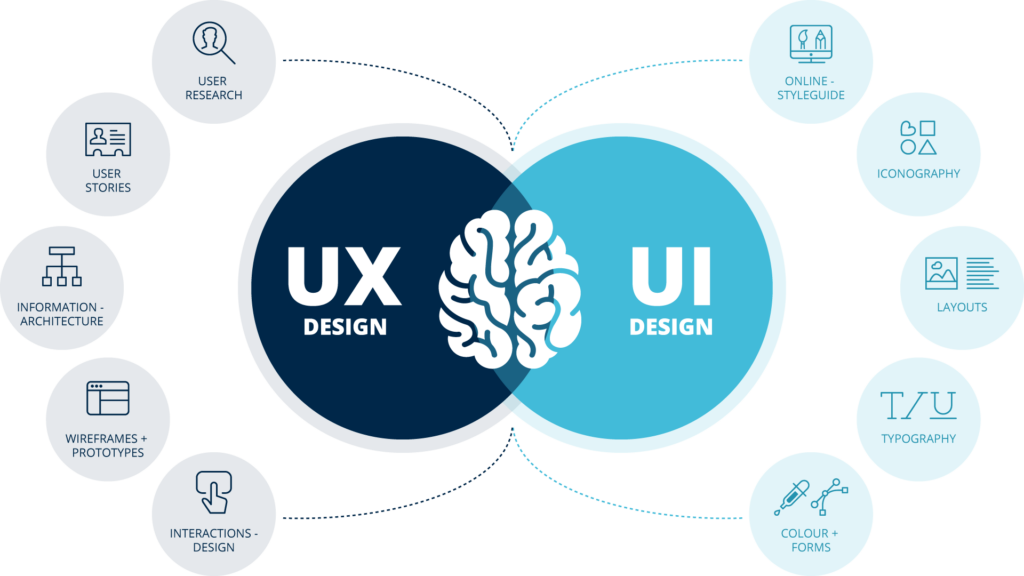Creating a good UI/UX design is crucial for delivering a seamless and engaging user experience. To achieve this, designers must follow certain principles and guidelines that ensure consistency and usability across the entire product. As trends and technology continue to evolve rapidly, staying updated on the latest best practices is essential.

Difference between UX and UI
Why Having Both UI and UX Design Are Important and Will Probably Boost Your Satisfaction
UI (User Interface) and UX (User Experience) are often mentioned together—and for good reason. While they serve different purposes, they are deeply interconnected and equally essential to creating a successful product. A good UI design focuses on the look and feel of your product, ensuring it is visually appealing and easy to navigate. On the other hand, a good UX design ensures that the product is functional and accessible, and provides a seamless user experience.
When these two elements are combined effectively, they create a product that not only meets the users’ needs but also enhances their overall satisfaction. Users are more likely to return to and recommend a product that is both visually engaging and easy to use. In today’s competitive market, having both a strong UI and UX design isn’t just a bonus—it’s a necessity.
By prioritizing both UI and UX in your design process, you can expect a significant boost in user satisfaction, which ultimately leads to higher engagement and conversion rates.
Here are the Top 10 Most Important Factors to Decide a Good UI/UX Design
While working on UI/UX design, there are principles and guidelines that can help you design a standard and consistent experience throughout your product. As trends and technology are constantly evolving and progressing, here are the top 10 most important factors to decide on a good UI/UX design in 2024.
1. Must Meet The Needs of Users
What value do your UX and UI design give to your customers, and what user needs are being met? These two questions should be front and center when contemplating and deciding on design elements.
Through aspects of branding, functionality, engagement, and ease of usability, good UX/UI design should provide users with an unforgettable experience that helps the brand or service. Take the iPhone for example. Sure, it’s a high-functioning smartphone, but its ease of usability and functionality is what has made it one of the most sought-after tech devices on the market today. Apple has without a doubt mastered the art of seamless UI/UX designs that effortlessly meets the needs of its users.
2. Establish a Clear Hierarchy From The Get-Go
Your webpage’s visual hierarchy is the order in which your information will be shown to users. It helps lead visitors to important content, links, and other areas of engagement. Visual hierarchies are meant to help users reach an objective, and the order in which information is displayed plays a vital role in accomplishing end goals.
As such, it’s important to establish a clear hierarchy in the beginning stages of your design. What information takes precedence? Will click A lead to click B? Hierarchies can be thought of as a cause-and-effect relationship, or a chain of actions that lead to the desired end result.
3. Consistency Through the Whole Process
Few conversions can be achieved without consistency. In UI/UX design, consistency means organization and planning. Your webpage or app should create a user-friendly atmosphere where clients don’t get lost or tangled in extraneous elements of your design. This might mean choosing a minimal design without the added bells and whistles. The bottom line is that your design elements must remain consistent from the beginning of the user experience until the very end.
A consistent approach to design with much attention to detail will without a doubt lead to more users and return rates than a product that lacks consistency.
4. Easily Accessible to All Users
It seems every tech company in the world is constantly releasing an endless stream of new and improved gadgets and devices from smartphones to laptops, cameras to smartwatches; each one requiring a daily update or software fix. On top of this fast-moving wave of digitalization, it can be difficult for software designers to keep up with ever-changing market demands.
However, it must be taken into consideration that a good UI/UX design is accessible to every user. Experiences should be the same whether the user is engaging via a smartphone, tablet, laptop, or whatever other new-fangled device hits the market. Remember, consistency is key.
5. User Context is Key
User experience and engagement are heightened when context is understood. What is the user’s purpose for utilizing your service? Why have they come to use your product? How comfortable are they using your app? Designing with context in mind can help address such concerns sooner rather than later.
Luckily, there exists emerging AI that can provide hard data based on users’ experiences on your platform. Yet until that technology is commonplace, you’ll have to gauge context in other ways.
It’s best to avoid assumptions. Customize based on user feedback and experiences. This, however, can be a challenge, as few experiences will be the same.
6. The User Interface should be Aesthetic
UI designs incorporate colors, images, typography, icons, content, and much, much more. Each of these elements plays a vital role in shaping your overall UI design. Let’s take a color for example. Each specific color has the possibility to change a user’s experience on a webpage. Red can symbolize love and energy, while yellow is the color of happiness and warmth. While the color choice may seem petty, it can have a lasting impression on your traffic and make or break sales.
The bottom line is that aesthetics matter. A visually appealing and engaging UI design will undoubtedly have higher success than the ones that don’t.
7. Make the Product as Clear as Possible
Users should not get lost in ambiguity. Think of them as a mouse, your UI design as a maze, and the cheese as your end objective. The less challenging the maze (UI/UX design) the quicker the mouse will reach the cheese. Or without the analogy; your design should make the product or end goal as clear as possible without added elements to get lost in.
This can be challenging considering all the in-demand design features and constantly evolving trends. However, nothing makes a user exit an app or platform quicker than getting lost in the user journey. As such, make sure their path to your desired end result is transparent and clear of obstacles.
8. Information Must Be True
Internet scams, digital fraud, fake news, and data privacy concerns are at the center of the online discussion in 2024. It’s true that as the world moves deeper into the digital era there exist more concerns regarding fraudulent or misleading information. As such, it’s important to keep in mind that any information attached to your product or online service must be accurate and verifiable to the best of your knowledge. After all, there’s a good chance it will be around forever.
Providing users with trustworthy and reliable content will work in your favor in the long run, as more users are seeking faithful and honest online experiences in this unfortunate age of misinformation.
9. Detailed-Oriented Mindset
Ensuring that relevant information is communicated specifically and with detail can make or break your design and ultimately impact the level of your product’s success.
Although it might seem counter-intuitive, UI/UX design should not necessarily be thought of as elements that need to be perfected. Rather, ‘perfection’ should be thought of as your design’s ability to solve problems and reach your end goals. Whether it be a sale or other conversion, this goal will likely be constantly changing and evolving. Therefore, a detail-oriented mindset is key to keeping up with ever-changing market demand and tech developments.
10. Innovation to the Very End
Few products or ideas find success by reinventing the wheel. As UX design has shifted upstream towards service and design strategies, it’s critical to keep in mind new and emerging trends to innovate and grow your product and services.
For example, projection technologies, augmented/mixed reality, and embedded home appliances are just a few areas where UI/UX design can integrate different concepts of innovation. Add to this list voice interfaces, talk-to-text programming, musical applications, and various other AI, and there’s plenty of space to evolve and innovate to the very end of your idea space.
Conclusion
Great UI/UX designs are difficult to achieve. Meeting the needs of users through detail-oriented, aesthetically pleasing, and functional designs will result in more conversions, and success, and keep you safely ahead of the competition. Through innovation and progressive design thinking, your UI/UX designs will surely stand out against all others.




